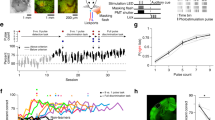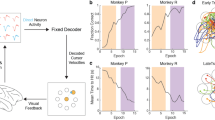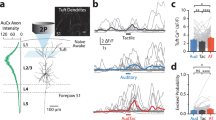Abstract
Brain-machine interfaces are not only promising for neurological applications, but also powerful for investigating neuronal ensemble dynamics during learning. We trained mice to operantly control an auditory cursor using spike-related calcium signals recorded with two-photon imaging in motor and somatosensory cortex. Mice rapidly learned to modulate activity in layer 2/3 neurons, evident both across and within sessions. Learning was accompanied by modifications of firing correlations in spatially localized networks at fine scales.
This is a preview of subscription content, access via your institution
Access options
Subscribe to this journal
Receive 12 print issues and online access
$209.00 per year
only $17.42 per issue
Buy this article
- Purchase on Springer Link
- Instant access to full article PDF
Prices may be subject to local taxes which are calculated during checkout


Similar content being viewed by others
References
Nicolelis, M.A.L. Nature 409, 403–407 (2001).
Carmena, J.M. et al. PLoS Biol. 1, e42 (2003).
Hochberg, L.R. et al. Nature 485, 372–375 (2012).
Collinger, J.L. et al. Lancet 381, 557–564 (2013).
Green, A.M. & Kalaska, J.F. Trends Neurosci. 34, 61–75 (2011).
Jarosiewicz, B. et al. PNAS 105, 19486–19491 (2008).
Ganguly, K., Dimitrov, D.F., Wallis, J.D. & Carmena, J.M. Nat. Neurosci. 14, 662–667 (2011).
Koralek, A.C., Costa, R.M. & Carmena, J.M. Neuron 79, 865–872 (2013).
Koralek, A.C., Jin, X., Long, J.D. II, Costa, R.M. & Carmena, J.M. Nature 483, 331–335 (2012).
Hilário, M.R.F., Clouse, E., Yin, H.H. & Costa, R.M. Front. Integr. Neurosci. 1, 6 (2007).
Dias-Ferreira, E. et al. Science 325, 621–625 (2009).
O'Connor, D.H., Peron, S.P., Huber, D. & Svoboda, K. Neuron 67, 1048–1061 (2010).
Barth, A.L. & Poulet, J.F.A. Trends Neurosci. 35, 345–355 (2012).
Shoham, S., O'Connor, D.H. & Segev, R. J. Comp. Physiol. A Neuroethol. Sens. Neural Behav. Physiol. 192, 777–784 (2006).
Komiyama, T. et al. Nature 464, 1182–1186 (2010).
Engelhard, B., Ozeri, N., Israel, Z., Bergman, H. & Vaadia, E. Neuron 77, 361–375 (2013).
Costa, R.M. Curr. Opin. Neurobiol. 21, 579–586 (2011).
Harris, K.D. & Mrsic-Flogel, T.D. Nature 503, 51–58 (2013).
Gdalyahu, A. et al. Neuron 75, 121–132 (2012).
Chen, T.-W. et al. Nature 499, 295–300 (2013).
Holtmaat, A. et al. Cold Spring Harb. Protoc. 2012, 694–701 (2012).
Pologruto, T.A., Sabatini, B.L. & Svoboda, K. Biomed. Eng. Online 2, 13 (2003).
Han, Y.K., Köver, H., Insanally, M.N., Semerdjian, J.H. & Bao, S. Nat. Neurosci. 10, 1191–1197 (2007).
Guizar-Sicairos, M., Thurman, S.T. & Fienup, J.R. Opt. Lett. 33, 156–158 (2008).
Acknowledgements
We thank V. Jayaraman, R. Kerr, D. Kim, L. Looger and K. Svoboda for generously sharing gCaMP material, and V. Athalye and K.D. Smith for technical assistance. This work was supported by US National Institutes of Health grant 1R01NS072416-01 to D.E.F., National Science Foundation grant CBET-0954243 to J.M.C., European Research Council grant 243393 to R.M.C. and National Science Foundation Graduate Research Fellowship grant DGE 1106400 to K.B.C.
Author information
Authors and Affiliations
Contributions
K.B.C., A.C.K., R.M.C., D.E.F. and J.M.C. designed the experiments. K.B.C. and A.C.K. built the experimental apparatus, performed the experiments and analyzed the data. K.B.C. performed surgical procedures. A.C.K. and K.B.C. wrote the paper. K.B.C., A.C.K., R.M.C., D.E.F. and J.M.C. revised the paper.
Corresponding authors
Ethics declarations
Competing interests
The authors declare no competing financial interests.
Integrated supplementary information
Supplementary Figure 1 Mice rapidly learn to intentionally modulate calcium dynamics.
a. Task schematic. b & c. Behavioral performance over 8 days for animals trained to use M1 (b) and S1 (c). d. Hit rate increases over the course of individual sessions. Shaded region denotes s.e.m., 10 mice. e. Animals achieve a criterion performance of 50% hits faster over the course of training. N=8 days, 10 mice
Supplementary Figure 2 Task performance does not rely on natural movements.
a. Performance on the task was not impaired when we injected lidocaine into the mystacial pad to block whisker movements and somatosensory input. Error bars denote s.e.m. b. Accelerometer traces for a single trial with no motion or licking behavior before target achievement, despite clear activity afterwards as mice consume the reward. c. Hit-locked accelerometer traces averaged over one entire training session for one animal shows animal does not rely on systematic motion for task.
Supplementary Figure 3 Fluorescence modulations during contingency reversal experiments.
a. When the identity of output cells is changed from day 1 to day 2, animals learn to reverse the activity patterns of their output neurons. b. ΔF/F E1/E2 ratio increases over the course of training on day CR2 (N=3 mice, 20 time points, R2=0.832, p=0.02, t(18)=13.32). Error bars s.e.m.
Supplementary Figure 4 Fluorescence modulations during contingency degradation experiments
a. Mean fluorescence decreases in E1 cells during the contingency degradation manipulation. b. Mean ΔF/F is unchanged in E2 cells over the course of a normal training session (N=5 mice, 20 time points, p=0.234,t(18)=1.23). c. Mean ΔF/F is unchanged in E2 cells during the contingency degradation manipulation (N=5 mice, 20 time points, p=0.13,t(18)=−1.58). Together, these results suggest that animals primarily perform the task by modulating mean activity in E1 cells and do not coarsely modulate the mean activity of E2 cells. Error bars in all panels represent mean +/− SEM.
Supplementary Figure 5 Performance does not depend on baseline activity in E1 cells.
a. Behavioral performance plotted against the makeup of E1. In 40 sessions, E1 was composed of a mix of more- and less-active cells (defined as cells in the lowest quintile of spontaneous activity rates). In 6 training sessions, E1 was solely comprised of low-active cells, and in 4 cases all cells in E1 had zero baseline activity (filled circles); in three cases the animal still performed the task above chance. Performance in both conditions was significantly better than chance (t-test, high- and low-active ensembles, p=2.2e-15, t(38)=11.69; low-active ensembles, p=0.02, t(5)=3.7). b. Analysis of the contribution of individual E1 cells to learned modulation of E1 ensemble activity. Fluorescence modulations around hits were calculated for each E1 cell, and normalized to the sum of modulations in the entire ensemble. Each cell's relative contribution to these modulations was then averaged over the entire training session, and plotted against the number of cells in the E1 ensemble. A bimodal distribution of contributions around 0 and 1 would suggest the task were carried solely by one cell in an ensemble. If all cells contributed equally, the distribution would peak around 1/N (red curve), where N = number of cells in the ensemble. The animals appear to use a combination of both strategies. Less-active neurons (in blue) contributed to hits in a manner indistinguishable from more-active neurons.
Supplementary Figure 6 Correlations between output cells increase over the course of a session and the course of training.
a. Z-scored correlations between output cells over the course of a behavioral session shown separately for each animal tested. All animals exhibit the same increasing trend that was seen in the mean. b. Correlations between output cells increase across days of training on the task (N=8 days, 10 mice, p=0.011, t(6)=3.59). The composition of ensembles varied across days, so this may reflect meta-learning rather than an increase in correlations between individual cells.
Supplementary Figure 7 Performance is not affected by the distance between output cells, but does depend on the number of cells in an ensemble.
a. There is no significant difference in performance during sessions in which the output cell ensembles were separated by less than 60 μm and those in which the ensembles were separated by more than 60 μm. Error bars denote s.e.m. b. Scatter of performance vs. distance between E1 and E2. c. Average performance vs. number of cells in E1 (blue) and E2 (green). Error bars denote s.e.m.
Supplementary Figure 8 Performance is affected by baseline correlations between ensembles.
a. Animals performed worse when E1 and E2 cells were more spontaneously correlated than when they were less correlated. (N=31 sessions, 10 mice). This effect was not evident b. within E1 or c. within E2.
Supplementary Figure 9 Indirect cells initially more correlated with output cells maintain output cell-like activity late in session
a. Indirect cells that were more spontaneously correlated with E1 cells (highest quintile of spontaneous correlations, >0.1) increase activity during task performance more than cells that were initially weakly, or anti-, correlated (t-test, p = 2.35e-5, t(849)=4.26). Horizontal bar indicates mean, vertical bar indicates standard deviation. b. Indirect cells that were more spontaneously correlated with E2 cells (highest quintile of spontaneous correlations, >0.17) show reduced activity during task perfomance compared with less-correlated cells (t-test, p = 0.01, t(849)=−2.6). Horizontal bar indicates mean, vertical bar indicates standard deviation. c. Spontaneous correlations between L2/3 neurons in mice fall off rapidly with short distances (binned mean shown in red, S1 and M1 data pooled).
Supplementary information
Supplementary Figures
Supplementary Figures 1–9 (PDF 571 kb)
Supplementary Methods Checklist
Reporting Checklist for Nature Neuroscience (PDF 213 kb)
Supplementary Video 1
Imaging field from an M1-implanted animal performing the neuroprosthetic task. (MOV 13577 kb)
Supplementary Video 2
Imaging field from an S1-implanted animal performing the neuroprosthetic task. (MOV 15665 kb)
Rights and permissions
About this article
Cite this article
Clancy, K., Koralek, A., Costa, R. et al. Volitional modulation of optically recorded calcium signals during neuroprosthetic learning. Nat Neurosci 17, 807–809 (2014). https://doi.org/10.1038/nn.3712
Received:
Accepted:
Published:
Issue Date:
DOI: https://doi.org/10.1038/nn.3712
This article is cited by
-
Real-time multimodal sensory detection using widefield hippocampal calcium imaging
Communications Engineering (2023)
-
Existing function in primary visual cortex is not perturbed by new skill acquisition of a non-matched sensory task
Nature Communications (2022)
-
Selective modulation of cortical population dynamics during neuroprosthetic skill learning
Scientific Reports (2022)
-
Two-photon calcium imaging of neuronal activity
Nature Reviews Methods Primers (2022)
-
Optical deep-cortex exploration in behaving rhesus macaques
Nature Communications (2021)



